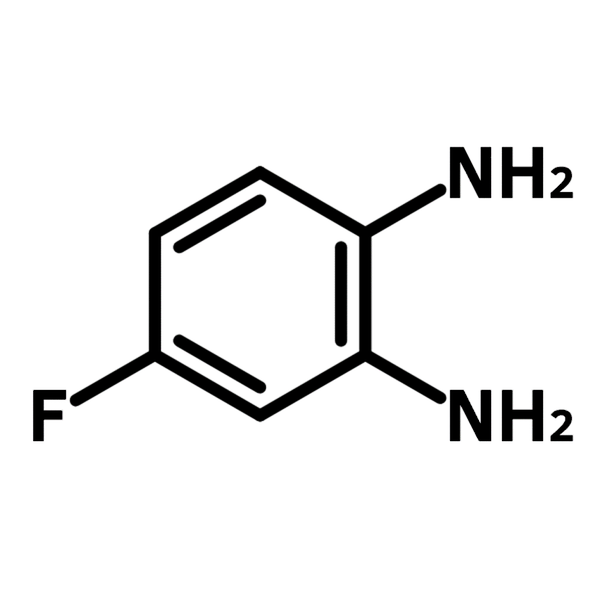4-Fluoro-1,2-phenylenediamine
CAS Number 367-31-7
Chemistry Building Blocks, Diamines and Dianhydrides, Fluorinated Building Blocks, Materials, Monomers, Non-Heterocyclic Building BlocksA fluorinated o-phenylenediamine building block
For the synthesis of Schiff bases in applications of APIs and batteries
Specifications | MSDS | Literature and Reviews
4-Fluoro-1,2-phenylenediamine (CAS number 367-31-7) is a fluorinated ortho-phenylenediamine. 4-Fluoro-1,2-phenylenediamine serves as a hardener for epoxy resins to enhance their thermal conductivity, thereby improving the thermal management of electrical motors and integrated circuits. The ortho-positioning of the amine groups enables 4-fluoro-1,2-phenylenediamine to form salen-type Schiff bases with salicylaldehydes. Such Schiff bases can coordinate to Co, Ni, Cu and Zn, affording corresponding organometallic complexes. The salen-type Schiff bases metal complexes show multiple applications, such as antimicrobial agents and redox carriers for flow batteries.
4-Fluoro-1,2-phenylenediamine is also utilized in the synthesis of 2,3-diaminophenazines through an oxidative reaction. 2,3-diaminophenazines have a wide range of applications in dyes and drug discovery.
Multiple functional groups
For facile synthesis
Fluorinated o-phenylenediamine building block
For drug discovery, Schiff bases, and battery research
Low Cost
Competitively priced, high quality product
High purity
>97% High purity
General Information
| CAS Number | 367-31-7 |
| Chemical Formula | C6H7FN2 |
| Full Name | 4-Fluoro-1,2-benzenediamine |
| Molecular Weight | 126.13 g/mol |
| Synonyms | 3,4-Diamino-1-fluorobenzene, 2-Amino-4-fluoroaniline, 4-Fluoro-o-phenylenediamine |
| Classification / Family | Fluorinated building blocks, Phenylenediamine building blocks, Ligands, Schiff bases, Batteries, APIs |
Chemical Structure

Product Details
| Purity | 97% |
| Melting Point | Tm = 94 °C – 98 °C |
| Appearance | Brown powder |
MSDS Documentation
 4-Fluoro-1,2-phenylenediamine MSDS Sheet
4-Fluoro-1,2-phenylenediamine MSDS Sheet
Literature and Reviews
- Fluorinated 2,3-diaminophenazines: synthesis, mechanism of formation, and properties, J. Li et al., New J. Chem., 47, 19556–19568 (2023); DOI: 10.1039/D3NJ02875E.
- GreenMedChem: the challenge in the next decade toward eco-friendly compounds and processes in drug design, C. Castiello et al., Green Chem., 25, 2109 (2023); DOI: 10.1039/d2gc03772f.
- Effect of amine hardener molecular structure on the thermal conductivity of epoxy resins, G. Lv et al., ACS Appl. Polym. Mater., 3, 259–267 (2021); DOI: 10.1021/acsapm.0c01074.
